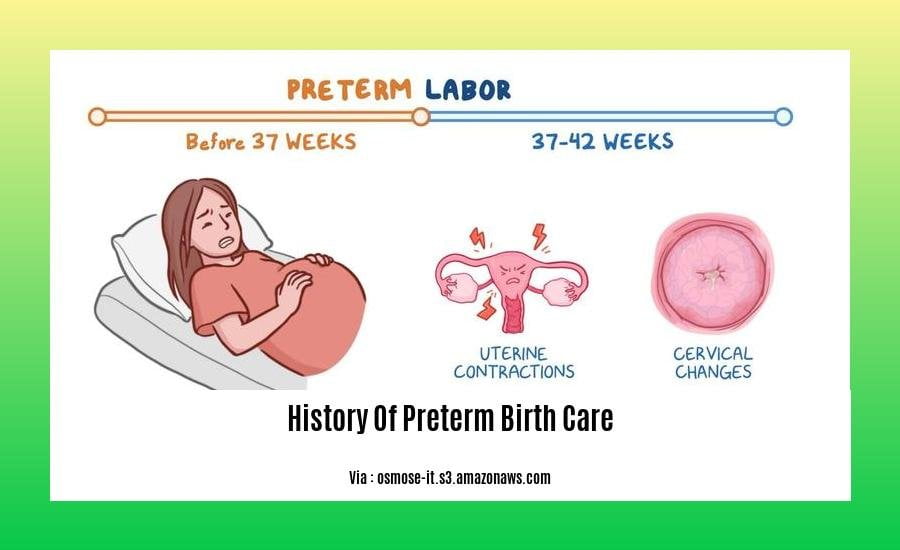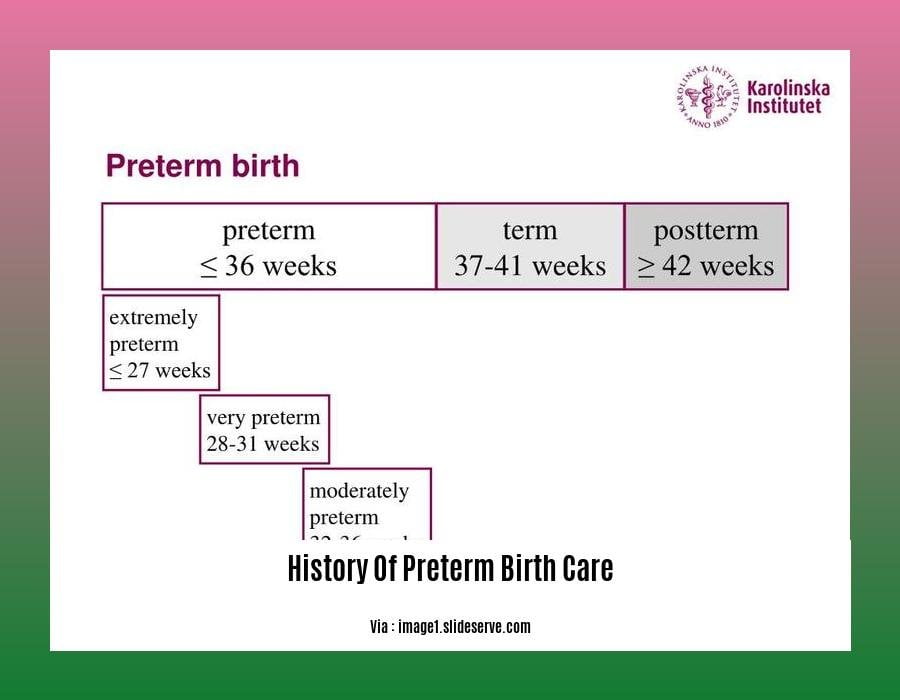Embark on a fascinating journey through [- The History of Preterm Birth Care: Unlocking the Secrets of Premature Infant Survival]. Discover the remarkable evolution of preterm care, from the early struggles of the late nineteenth century to the cutting-edge interventions of today.
Key Takeaways:
- Preterm infant survival rates have vastly improved over the past century.
- Early intervention and advanced technologies have been crucial to these improvements.
- Disparities in preterm birth rates exist globally.
- Continued research and collaboration are essential for further progress in premature infant care.
History of Preterm Birth Care

Throughout history, preterm birth care has evolved dramatically, reflecting advancements in medical knowledge and technology.
In the late 1800s, premature infants had poor survival rates due to limited medical interventions.
The early 1900s brought the invention of incubators, revolutionizing premature infant care. However, hospitals often lacked adequate resources for specialized care.
By the mid-1900s, preterm care expanded with improved understanding of infant needs and resource allocation.
During and after World War II, technological advancements and research propelled significant progress in premature infant care.
Despite advancements, prematurity remains a global challenge, with higher rates in certain regions.
Ongoing research and collaboration continue to drive innovation and improve outcomes for premature infants, resulting in increased survival and quality of life.
Discover the History of Preterm Birth and its impact on infant health. Explore the History of Preterm Delivery and its implications for expectant mothers. Learn about the History of Preterm Delivery in Currently Pregnant Women. Gain insights into the Family History of Preterm Labor and its significance. Delve into the intricacies of the History of Preterm Labor and its implications for future pregnancies.
Early Twentieth Century: Premature Infant Care Expands

In the early 20th century, advancements in premature infant care were pivotal in improving the survival rates of these vulnerable infants. Here are some key milestones:
- Incubators Revolutionize Care: The invention of incubators provided a controlled environment, mimicking the mother’s womb and protecting premature infants from temperature fluctuations.
- Premature Infant Stations: Specialized units dedicated to the care of premature infants emerged, such as the one at Chicago’s Michael Resee Hospital. These units provided dedicated staff and resources.
- Scientific Guidance: Dr. Pierre Budin’s groundbreaking textbook, published in 1901, provided comprehensive guidance on the unique needs of premature infants.
- Individualized Treatment: Physicians recognized the importance of tailored care, adjusting interventions based on the infant’s weight, gestation, and medical condition.
- Post-World War II Progress: Post-war efforts focused on expanding public health initiatives and improving access to premature care.
Key Takeaways:
- Incubators and premature infant stations provided critical support for premature infants.
- Dr. Pierre Budin’s textbook significantly advanced the understanding of premature infant care.
- Individualized treatment became a cornerstone of premature infant care.
- The post-World War II era brought renewed focus on public health efforts to improve premature care.
Relevant URL Sources:
- https://www.nursing.upenn.edu/nhhc/nurses-history-and-health-care/caring-for-the-premature-infant-a-historical-perspective
Academics: Unlocking the Secrets of Premature Infant Survival
Despite medical advancements, preterm birth remains a global challenge, accounting for nearly 10% of all births [WHO]. Premature infants face unique health challenges, often requiring specialized care to ensure their survival and long-term well-being. The history of preterm birth care is marked by continuous advancements that have dramatically improved outcomes for these fragile newborns.
The early 20th century witnessed the emergence of incubators, devices that provided a controlled environment to protect premature infants from temperature fluctuations [Care of Premature Infants]. Premature infant stations, dedicated units within hospitals, became specialized centers for providing these vulnerable newborns with the necessary care and resources [Preterm Birth – World Health Organization (WHO)].
Scientific advancements also played a pivotal role in shaping preterm birth care. Dr. Pierre Budin’s seminal textbook “The Nursling” provided comprehensive guidance on the unique needs of premature infants [Care of Premature Infants]. Individualized treatment plans tailored to the specific characteristics and needs of each infant became essential in ensuring their optimal care [Preterm Birth – World Health Organization (WHO)].
Collaboration between researchers, healthcare professionals, and policymakers has been crucial in driving progress in preterm birth care [Addressing Preterm Birth History With Clinical Practice Recommendations Across the Life Course]. Public health initiatives focused on expanding access to premature care and promoting preventive measures have significantly contributed to reducing preterm birth rates [Care of Premature Infants].
Key Takeaways:
- Incubators revolutionized premature infant care, providing a controlled environment for temperature regulation.
- Premature infant stations emerged as specialized units dedicated to providing comprehensive care.
- Scientific guidance from experts like Dr. Pierre Budin informed best practices in preterm infant care.
- Individualized treatment plans tailored to each infant’s unique needs became essential for optimal outcomes.
- Collaboration and public health initiatives have played a vital role in improving preterm birth care and reducing preterm birth rates.
Relevant URL Sources:
- Addressing Preterm Birth History With Clinical Practice Recommendations Across the Life Course
- Care of Premature Infants
FAQ
Q1: What were the survival prospects of premature infants at the end of the 19th century?
A1: Premature infants had dismal survival prospects in the late nineteenth century due to a lack of specialized care and knowledge about their unique needs.
Q2: When did the first incubator for premature infants emerge, and who was behind its development?
A2: The first incubator for premature infants was developed in 1880 by Martin Couney.
Q3: Which hospital established the first premature infant station, and who led this initiative?
A3: The first premature infant station was established at the Michael Reese Hospital in Chicago in 1888 under the leadership of Dr. Julius Hess.
Q4: What was the significance of Dr. Pierre Budin’s contribution to the field of premature infant care?
A4: In 1901, Dr. Pierre Budin published the first major textbook on the care of premature infants, providing a foundation for understanding their needs and improving their outcomes.
Q5: How did World War II impact the progress of premature infant care?
A5: During World War II, public health efforts to benefit premature infants were unfortunately postponed, as resources and attention were diverted to the war effort.
- Senior at What Age: Benefits & Eligibility Guide - March 29, 2025
- Unlocking Senior Benefits: How Old is a Senior? Your Complete Guide - March 29, 2025
- Master Russian Politeness:A Guide to Saying Please - March 29, 2025
















